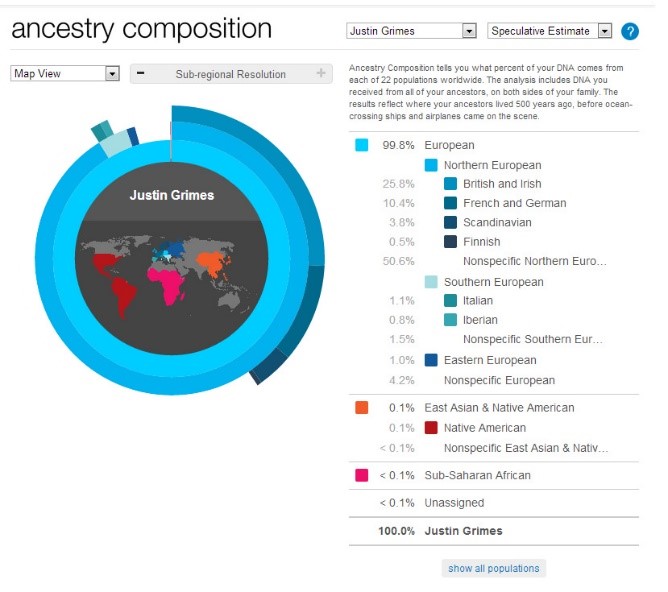On Learning to Read Your DNA’s Autobiography
Submitted by Kiara Sofia Vega-Bellido on
How significant has the discovery of deoxyribonucleic acid (DNA) as an organism’s genetic material been for the scientific advancement of humankind? Well, for starters, it is recognized as one of the most fundamental findings in biology, and has been a catalyst for countless developments in the field of genetics. According to Theodosius Dobzhansky’s famous (and accurate) quote “Nothing in biology makes sense except in the light of evolution”, and it is important to note that Darwin’s theory of evolution and the natural mechanisms driving evolution would remain ambiguous if it weren’t for our increasing knowledge of genetics. Our understanding of the biochemical vehicle for hereditary information, namely the combination of sequences composed of four nucleotides (Adenine, Thymine, Guanine, Cytosine) we commonly know as DNA has been the key to unlocking many mysteries of human biology. Applications range from evolutionary studies to forensics to early disease detection, and so on. Any future biologist worth their salt should be intimately acquainted with this molecule, its structure, function and the information it embodies.
An organism’s complete set of DNA is called a genome. Studying it can reveal incredible amounts of useful information about the organism, offering a sort of genetic autobiography detailing aspects about its ancestry, its health and even behavior. Recent technological advances which have facilitated the sequencing of the genetic code led to the elucidation of “nature’s complete genetic blueprint for building a human being” through the sequencing of the human genome in 2003. This milestone project naturally encouraged all types of developments in human genomics research and analysis, including a uniquely commercial product and Time’s 2008’s #1 Invention of the Year: 23andMe’s saliva-based direct-to-consumer personal DNA test kit. Buying 23andMe’s personal genome test kit entails providing a saliva sample to the company for DNA extraction, sequencing, and genomic analysis for genetic variation using an Illumina HumanOmniExpress-24 format chip. After analysis, the customer receives a detailed report on his or her ancestry composition, neanderthal percentage, maternal and paternal lineages, wellness (predisposition to medical conditions or traits), etc. Learning about your genetic composition allows you to know a bit more about your ancestral and fundamental biological identity as a human being. Not to mention the positive and negative predispositions that are inherent in your genetic design or “blueprint”, as the HGP puts it. It is almost inevitable that in the future personal genome testing will become commonplace as a standard medical practice.

If you decide to participate in personal genome testing (which I wholeheartedly encourage you to do), the analysis performed by 23andMe provides a downloadable data report about your single nucleotide polymorphisms or snps. Snps are single-base differences in your DNA that result in genetic variation. For example, if you have a snp in a certain position on a specific chromosome, this might mean you have a genetic predisposition to develop diabetes. Or a predisposition to weigh more than average. Or even more likely to have exceptionally agreeable body odor. In any case, with this downloadable data report provided by 23andMe, you can take it a step further and submit it to the website Promethease, pay $5, and receive a more thorough and comprehensive analysis of your snps.
Besides receiving all sorts of neat and relevant information about your genetic make-up, participating in 23andMe means you have the opportunity to contribute to research. Not just to the one funded by the company, but currently at the UPRM there are a group of undergraduate students interested in making use of 23andMe’s services in order to enhance their understanding of genome testing and analysis. These students have been a part of a special topics course titled “Biology of Genomes” where they ordered DNA testing kits and submitted their samples in order to use the results as controls in a subsequent course titled “Analysis of Genomes” where they could learn to study and analyze their results. The classes aim to provide a platform for students to learn how to analyze and understand their genomic data using accessible databases (e.g. SNPedia). Stanford School of Medicine published a study on this type of active learning with favorable results. This project is open to anyone who is interested in learning how to analyze their own genomic data and to interpret the information provided by their unique snps. If you are interested in taking a hands-on approach to learning about genetics and genomic analysis, these are courses you should definitively take in your following academic years.
Like and follow UPRM Science Communication Initiative on Facebook and Twitter @uprmsci!









